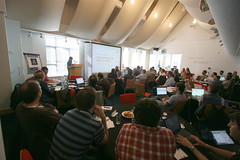
I am typing most of this on the train back from Birmingham, where I have been attending WordCampUK, a two day conference on all things to do with the greatest online publishing platform, like, ever. It was great to meet new folk, and friends too and as always, the value for me was in the conversations snatched over a cup of tea rather than the official sessions themselves.
Part of this was because WordCampUK was a curiously formal affair, with a proper agenda and with everyone attending all the same sessions, by and large. It was, I think it is fair to say, a lot more word than camp. One thing I couldn’t really understand was that there was a room available that wasn’t used at all, that would have been perfect as a breakout room for people to have off the cuff discussions and practical sessions.
I suppose it is a rather peculiar thing to try and form an event around a platform – the one thing we all had in common was the tool we use to get lots of wildly different stuff done. Finding common ground was therefore always going to be tricky, which made the lack of an official breakout space more of an issue.
Something that could be improved for next time would definitely be to introduce some flexibility into the agenda – at least to make people feel that they are able to leave a session in the main space if they don’t think it is really for them. There also needs to be enough room for manoeuvre in the sessions themselves, to let them fly off in a different direction than may have been originally intended.
The one session that was clearly missing was a show-and-tell – “Cool Stuff I’ve Done With WordPress” – give everyone who wants it five minutes to show off something they have done. Simon Dickson did a bit of this during his great session – the only one that really had everyone buzzing at the end. Presenting is clearly not as easy as it seems.
Some other positive stuff:
- The WordPress community in the UK is beginning to shape itself. I picked up several business cards from techie types which could well come in very handy in the future. I don’t see my future as being too much about building stuff, rather enabling people to realise how the social web can help them, and maybe joining the folk up who can get stuff done. Knowing the people with the skills will be vital.
- There was a very interesting discussion around SEO, on which I made some notes on this blog. The key message was to make sure your content is well written and interesting. There is still a lot for government to learn about this stuff, as Paul Canning often says – maybe we should call it findability or something, though.
- Jon Bounds is a ludicrously amusing quiz show host. His quiz was pointlessly hard, and yet somehow the team I was on won. Huzzah! One green WordPress tshirt for me – lets hope it fits.
- There was much twittering going on, and despite the use of the hashtag, the most useful way of monitoring it all was a Summize Twitter Search for the wordcampuk tag. It did descend into snarkiness on a couple of occasions, but that was probably necessary at that particular point in time. Twitter is like passing notes round class for the 21st century, and was laugh out loud funny on occasions
- Simon’s announcement that the new site for 10 Downing Street will be running on WordPress drew several gasps from the attendees. It’s big news for those trying to sell the use of WP to large organisations: after all, if it’s good enough for Gordon…
Some stuff needs to be done to develop the community, to draw others in that couldn’t make the event and to really make the most of the connections being made.
- Let’s get a WordPress UK planet of blogs set up, so we can all keep up with what one another is saying
- Let’s get a community network built, where we can all list ourselves, our interests, skills, knowledge, availability etc
- Let’s start planning the next event, and make sure it’s flexible, informal and fun
So well done to those who organised the event, but I guess the real work starts now.
